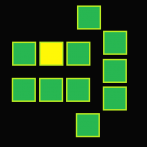ASCII Game of Life
No, this is not the board game. This game is John Conway's Game of Life
- ASCII version. This game is a zero player game
- a cellular automaton
- a "discrete model studied in computability theory, mathematics, physics, complexity science, theoretical biology and microstructure modeling. Cellular automata are also called cellular spaces, tessellation automata, homogeneous structures, cellular structures, tessellation structures, and iterative arrays. "
"A cellular automaton consists of a regular grid of cells, each in one of a finite number of states, such as on and off (in contrast to a coupled map lattice). The grid can be in any finite number of dimensions. For each cell, a set of cells called its neighborhood (usually including the cell itself) is defined relative to the specified cell. An initial state (time t=0) is selected by assigning a state for each cell. A new generation is created (advancing t by 1), according to some fixed rule (generally, a mathematical function) that determines the new state of each cell in terms of the current state of the cell and the states of the cells in its neighborhood. Typically, the rule for updating the state of cells is the same for each cell and does not change over time, and is applied to the whole grid simultaneously, though exceptions are known, such as the probabilistic cellular automata and asynchronous cellular automaton.The concept was originally discovered in the 1940s by Stanislaw Ulam and John von Neumann while they were contemporaries at Los Alamos National Laboratory. While studied some throughout the 1950s and 1960s, it was not until the 1970s and Conway's Game of Life, a two-dimensional cellular automaton, that interest in the subject expanded beyond academia. In the 1980s, Stephen Wolfram engaged in a systematic study of one dimensional cellular automata, or what he calls elementary cellular automata, showing that some of the rule sets were Turing-complete. He published A New Kind of Science in 2002, claiming that cellular automata have applications in many fields of science."
- ASCII version. This game is a zero player game
- a cellular automaton
- a "discrete model studied in computability theory, mathematics, physics, complexity science, theoretical biology and microstructure modeling. Cellular automata are also called cellular spaces, tessellation automata, homogeneous structures, cellular structures, tessellation structures, and iterative arrays. "
"A cellular automaton consists of a regular grid of cells, each in one of a finite number of states, such as on and off (in contrast to a coupled map lattice). The grid can be in any finite number of dimensions. For each cell, a set of cells called its neighborhood (usually including the cell itself) is defined relative to the specified cell. An initial state (time t=0) is selected by assigning a state for each cell. A new generation is created (advancing t by 1), according to some fixed rule (generally, a mathematical function) that determines the new state of each cell in terms of the current state of the cell and the states of the cells in its neighborhood. Typically, the rule for updating the state of cells is the same for each cell and does not change over time, and is applied to the whole grid simultaneously, though exceptions are known, such as the probabilistic cellular automata and asynchronous cellular automaton.The concept was originally discovered in the 1940s by Stanislaw Ulam and John von Neumann while they were contemporaries at Los Alamos National Laboratory. While studied some throughout the 1950s and 1960s, it was not until the 1970s and Conway's Game of Life, a two-dimensional cellular automaton, that interest in the subject expanded beyond academia. In the 1980s, Stephen Wolfram engaged in a systematic study of one dimensional cellular automata, or what he calls elementary cellular automata, showing that some of the rule sets were Turing-complete. He published A New Kind of Science in 2002, claiming that cellular automata have applications in many fields of science."
Category : Puzzle

Related searches
Reviews (2)
A. G. u.
Nov 22, 2018
Its what it says it is. Ascii Conway's Game of Life. Nothing more or less. If someone hates it, they might not realize its not a regular video game.



it is indeed a game of life simulator. it is free so I can't be too hard on it, but I would have given a higher rating if I could draw my own cells or if there were premade patterns (spaceships, gliders, factories, etc) that I could insert.